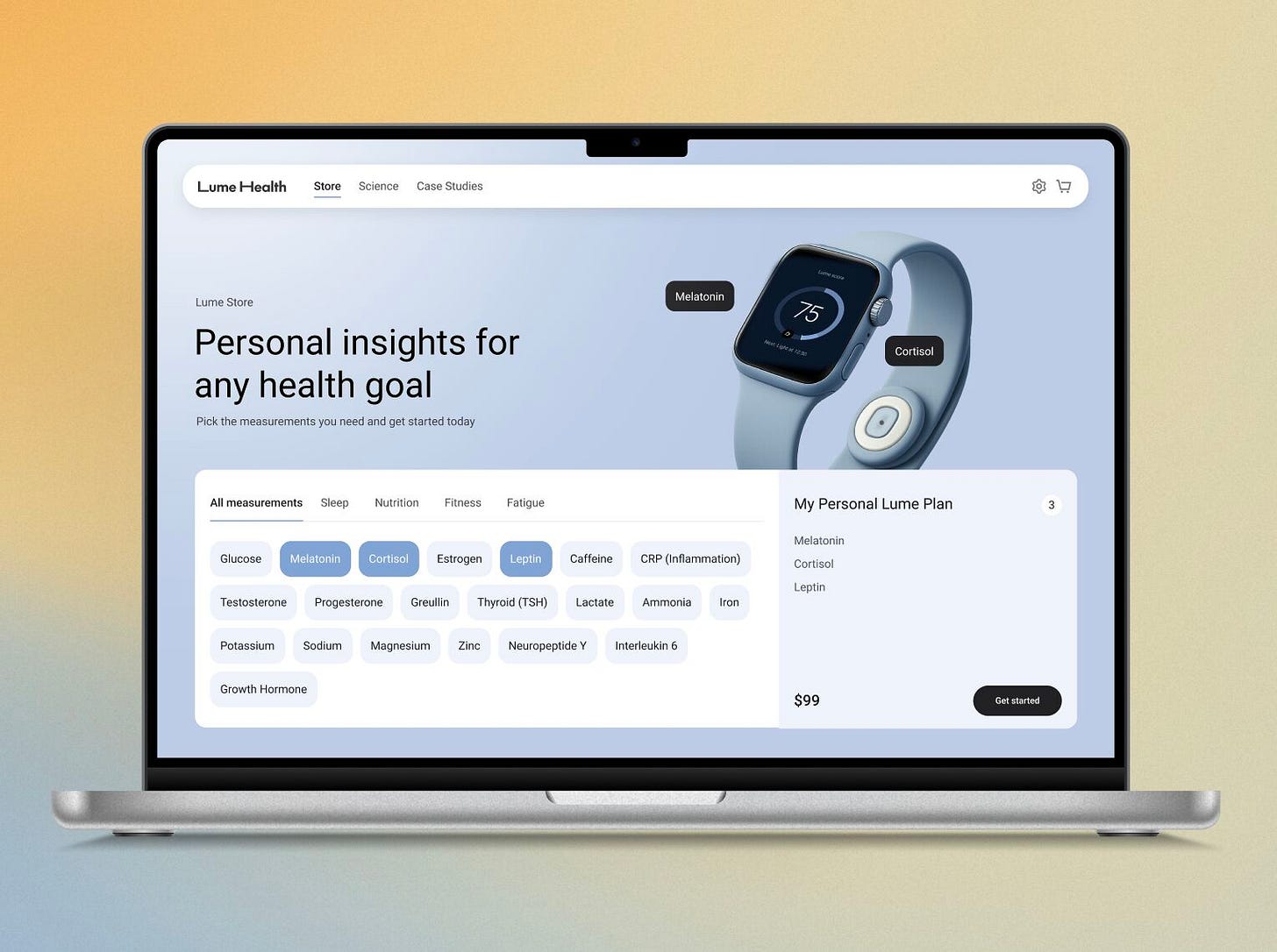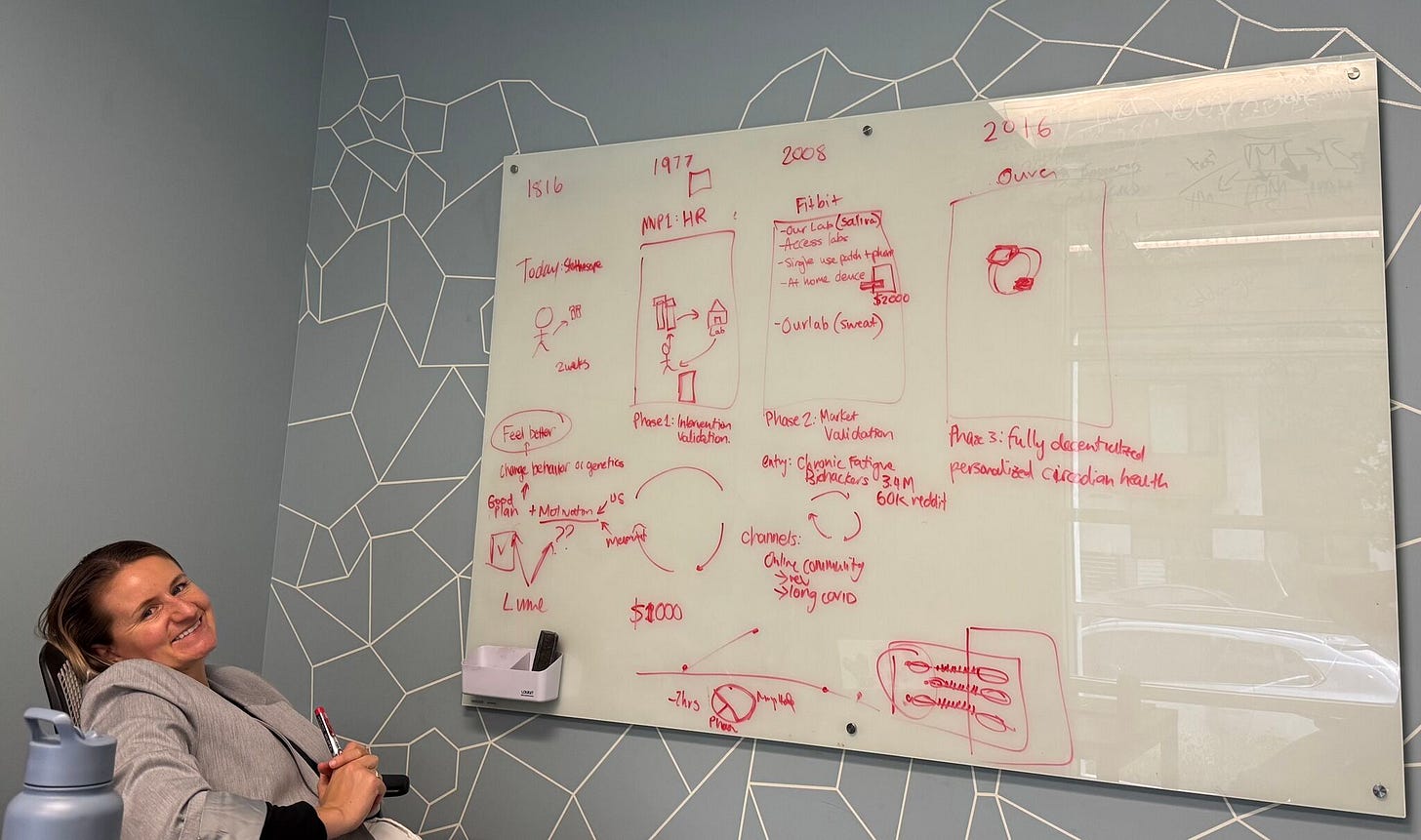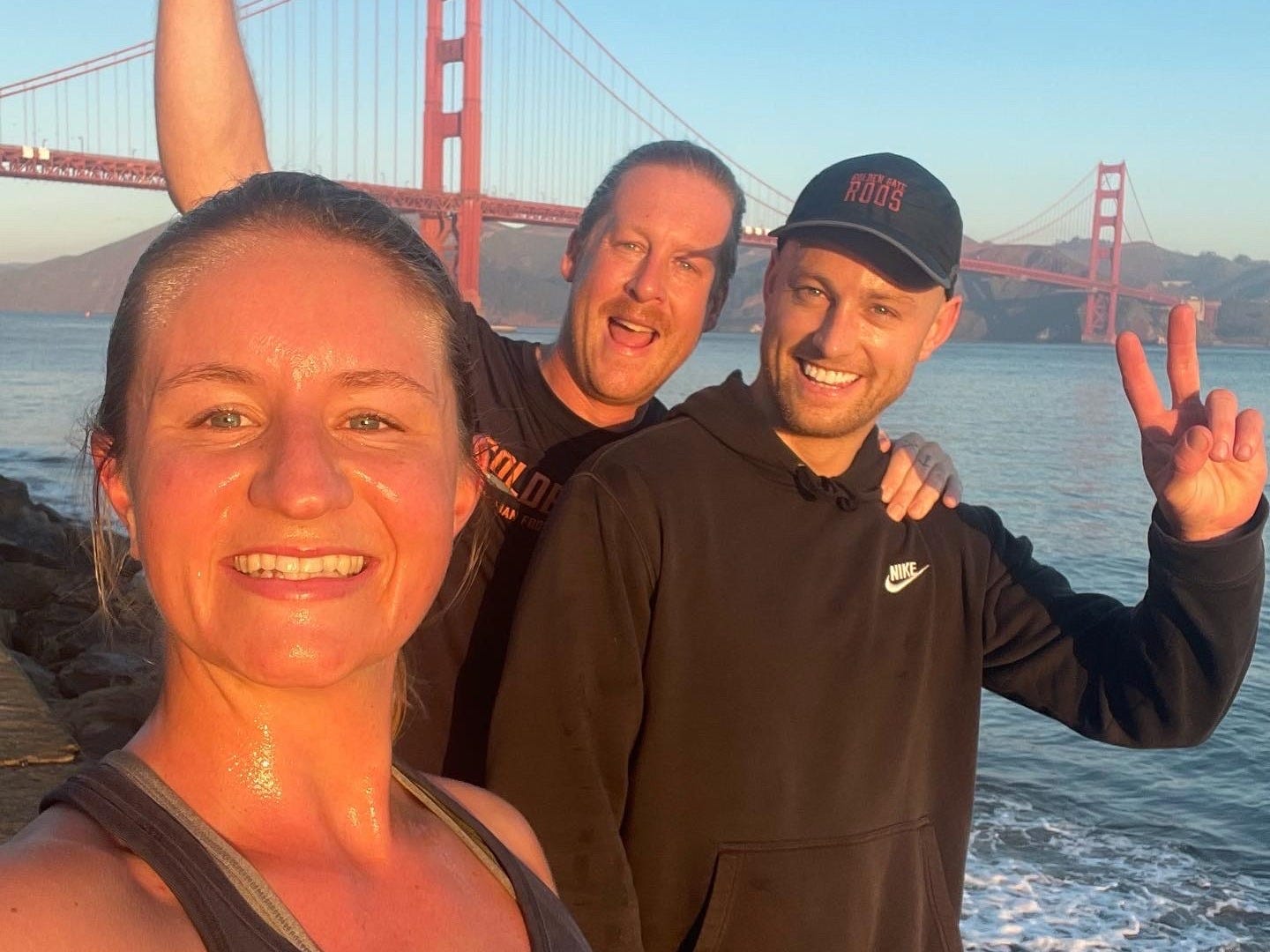This CEO of a Circadian Health Tech Company Follows Her Own Rhythm
Lume Health co-founder Vicki Powell shares a day in her life as she develops the first wearable aimed at repairing our fragile circadian rhythms
Vicki Powell once built watch sensors for Apple. Today, she’s the CEO and co-founder of Lume Health, a company that’s developing the first wearable device that monitors hormone levels in real-time.
As the leader of a fast‑growing health startup, Vicki’s days involve brainstorming, traveling, and poring over case studies until her eyes become blurry. But she also makes time to enjoy life’s simple pleasures: running, reading, spending time with friends — and of course, getting a good night’s sleep.
Learn about the innovative tech Lume is creating to help people better understand the natural rhythm of their bodies, and find out how co-founder Vicki navigates hectic schedules while honoring her inner timekeeper.
The origin of Lume
Wearable tech has greatly evolved over the last several years. The most popular smartwatches and smart rings can measure heart rate variability, blood oxygen, and basal body temperature for ovulation, but not the hormones that regulate our circadian rhythms.
Vicki met Dr. Jonathan Moustakis — her co-founder and Lume Health CTO — during an MBA program at Oxford University. The two became friends and endeavored to create a device that would identify and solve the root cause of the health issues that silently affect so many people.
Lume is the culmination of Vicki’s experience developing sensors for the Apple Watch and Jonathan’s background as a medical doctor who has used AI-powered systems for Tuberculosis screenings. It’s also built upon extensive research on circadian health, a growing team of ambitious scientists and engineers, rigorous product testing, and a desire to help people take back control of their lives.
“We built Lume to help you have more information about your body, so you can live your healthiest life and get the most out of each day,” Vicki says. “This isn’t just about sleep. It’s about empowering you to build a lifestyle where you show up the way you want to.”
How Lume interprets your body’s rhythm
Circadian rhythm sleep disorders affect around 3% of adults, yet they’re often misdiagnosed as insomnia1. Even though such diagnoses are quite rare, countless others still suffer from circadian disruptions as a result of jet lag, shift work, and irregular sleep‑wake schedules.
When our circadian rhythm is off balance, the immediate effects usually manifest as tiredness, headaches, lack of focus, and irritability. Long-term effects can negatively impact our cardiovascular health, mental health, metabolism, and bone density. Some studies even link chronic circadian irregularity to increased cancer risk23.
Lume’s mantra is, You can’t improve what you can’t measure. Until now, there hasn’t been a wearable that records hormone fluctuations, which could be a reason why people are puzzled by their exhaustion after achieving an excellent sleep score.
“This isn’t just about sleep. It’s about empowering you to build a lifestyle where you show up the way you want to.”
Lume uses a DNA-based sensor to measure cortisol and melatonin — the hormones that influence alertness and tiredness, respectively — and tracks how those levels shift throughout the day. It then maps your circadian rhythm, revealing how your habits, environment, and lifestyle choices affect your energy.
The Lume App is currently available for beta testing for iOS users4. Meanwhile, here’s what’s to come from Lume Health:
LumeHome: A wearable hormone tracker paired with an app that displays real-time readings and delivers AI-driven insights tailored to your unique needs. (Expected launch: Q1 2026; now in beta)
LumeBand: A non-invasive wearable sensor that analyzes sweat to monitor hormones and circadian health. (Expected launch: 2027)
Sign up to become a beta tester and stay updated on new product drops by joining the Lume Health waitlist.
“I didn’t realize how fragile my circadian rhythm was.”
For years, Vicki witnessed her friends and family struggling with poor sleep and other maladies despite the monumental advancements in wearable technology. “Surely we didn't evolve to suffer this much,” she laments.
Since co-founding Lume Health, Vicki realized that she was unknowingly putting her own well-being at risk, too.
“Before Lume, I didn’t realize how fragile my circadian rhythm was — or how much it controlled. I used to push through, working late into the night in bright environments,” she says.
Although she’s busier than ever these days, Vicki feels like she has a lot more control over her health and sleep because she follows the right cues for her body. “I notice my light habits with much more intention, and I know when to rest,” she adds.
Here’s a day in the life of Vicki Powell, CEO and co-founder of Lume Health…
Most days, I wake up at...
6:30–7:00 am. I generally don't set an alarm unless I've got something earlier than usual or something I can't miss before 7:30 am.
What gets me out of bed every morning is...
Making myself my favorite drink, a banana smoothie, before my workout.
My morning routine typically consists of...
Opening the blinds, going for a short run outside (or walking to the gym), and prioritizing getting my eyes in the light. (I notice it really helps me start my day.) Then I shower, have breakfast, check emails, and plan for the day.
On a typical weekday, you can find me...
In calls, whiteboarding, reading research papers, sketching product ideas, answering emails, and trying to stay focused while juggling five balls at once.
Whenever I need a mid-day energy boost, I...
Get outside and get some sunlight. Even five minutes in natural light can boost my energy. (I often tell people you should be considering your light habits just as much as your eating and exercise habits.)
To signal the end of my workday, I...
Light candles and read or journal to reflect on my day and the bigger picture.
In the evening, I like to relax by...
Spending time with friends, going for a sunset walk, or reading.
I know it's time to get ready for bed when...
I feel my eyes start to get heavy.
My wind-down routine typically consists of...
Dimming lights and journaling. I turn my screen brightness way down and avoid anything too stimulating.
I absolutely cannot sleep without...
Darkness. I also love wearing earplugs to avoid noises waking me up.
My regular bedtime is...
10:30–11:00 pm.
On weekends and holidays...
I generally try to keep my sleep/wake routine as similar as I can. Even if I stay up a little later, I try to keep my wake time the same to reduce fatigue during the week.
Are you tuned in to your circadian rhythm? If you are, how did you learn to listen to your body? If you’re not, will you draw inspiration from Vicki’s daily routine? Let us know — share your thoughts below!
Like this post? Here’s another story you may want to check out:
I Forgot to Replace My Bedroom Clock and My Sleep Has Never Been Better
Time. We either have too much of it or not enough, and nothing makes that more obvious than a clock.
Coming later this month… I’m a Mattress Tester — Ask Me Anything!
Wondering if I think cheap Amazon mattresses are comfortable, or if I would ever tape my mouth shut to sleep better? Here’s your chance to ask your questions for my first-ever AMA at the end of June! You can send me a question via Substack or LinkedIn.
Subscribers can head to the MTM chat to drop their Qs, too:
Disclaimer: The information in this post is for informational and entertainment purposes only and should not be considered medical advice. If you have sleep-related issues or concerns, please consult with your doctor or a qualified healthcare provider.
Kim MJ, Lee JH, Duffy JF. Circadian Rhythm Sleep Disorders. J Clin Outcomes Manag. 2013 Nov 1;20(11):513-528. PMID: 25368503; PMCID: PMC4212693.
Zhou, L., Zhang, Z., Nice, E. et al. Circadian rhythms and cancers: the intrinsic links and therapeutic potentials. J Hematol Oncol 15, 21 (2022). https://doi.org/10.1186/s13045-022-01238-y
Marie Pariollaud et al. Circadian disruption enhances HSF1 signaling and tumorigenesis in Kras-driven lung cancer.Sci. Adv.8,eabo1123(2022).DOI:10.1126/sciadv.abo1123
:cries in Android as tears fall on my Samsung Galaxy 24:












